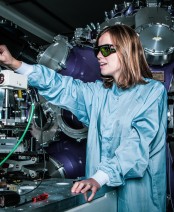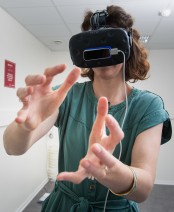Polarised light, a new biomedical diagnostic tool


The development of medical imaging techniques during the 20th century has greatly improved diagnosis, treatment and patient care. New techniques continue to emerge, such as Mueller polarimetric imaging. This technique exploits the polarisation of light, a property that is highly relevant for determining wheter a biological tissue is healthy or not.
Light is made up of an electric field and a magnetic field that oscillate in time and are strongly interconnected. The polarisation is the path of the electric field. In general, the polarisation state of light changes after interaction with a material, such as biological tissue. By characterising this change, it is possible to determine the polarimetric properties of the tissue under study and thus obtain information about its microstructure.
"The main polarimetric properties that characterise biological tissues are linear birefringence and depolarisation. The former is related to the presence of ordered structures such as collagen and elastin fibers or muscle fibers. The latter characterises the capacity of a tissue to scatter light due to the presence of structures such as cellular organelles or disorganised fibers of the extracellular matrix” explains Angelo Pierangelo, researcher in charge of the biomedical polarimetric imaging activity at the Laboratory of Physics of Interfaces and Thin Films (LPICM*). This researcher is leading the work within a large multidisciplinary collaboration whose main objective is to explore the promise of this method for in vivo analysis of the microstructure of the uterine cervix in order to improve the detection of cancer or, during pregnancy, to prevent the risk of premature birth.
This in vivo analysis is currently impossible with conventional techniques based on light intensity measurements. Angelo Pierangelo and his team have therefore developed a Mueller polarimetric colposcope, which was made by modifying a conventional colposcope, i.e. a low-magnification binocular microscope already used in medicine to analyse the surface of the uterine cavity. This new colposcope emits light with well-defined polarisation states towards the tissue and analyses the light backscattered from it. The "Mueller matrix" is thus reconstructed. It contains all the polarisation properties of a biological tissue. "Our colposcope makes it possible to acquire in vivo images at several wavelengths from blue to near infrared and thus to explore the tissue at different depths in one second, with a macroscopic field of view and a spatial resolution of about 50 micrometres per pixel," summarises the researcher. "Furthermore, the examination does not involve any danger for the patients and is very simple for the doctor, as it does not change established medical practice.”
The interest of this technique has already been demonstrated for the preventive detection of cervical cancer, which remains one of the most frequent cancers in women worldwide due to its incidence in low-resource countries that lack effective and inexpensive screening techniques. A large ex vivo study was conducted at the LPICM as part of the "PAIR Gynéco" project funded by the French National Cancer Institute. Its conclusion indicates that polarimetric imaging is promising for detecting the presence of precancerous lesions. The potential of the technique in vivo was also demonstrated and published in a scientific paper, which was a world first. A clinical study is currently being prepared.
Another possible application of this improved colposcope emerged during discussions between the researchers and gynaecologists. They noted that cervical polarimetry is highly dependent on collagen, a protein that provides mechanical properties to tissue. Premature remodelling of cervical collagen is thought to be the main cause of premature delivery, which is the leading factor of perinatal mortality and morbidity in the world. The gold standard for diagnosis and risk assessment of premature delivery is currently transvaginal ultrasound, which measures the length of the cervix. "But this is a very qualitative technique that does not allow for a reliable diagnosis," says Pierangelo. There is room for improvement, particularly in terms of reliably detecting premature deliveries, thus avoiding unnecessary preventive hospitalisations that can lead to complications for the pregnant woman.
A patent has therefore been filed for the method of pregnancy monitoring using the colposcope. In addition, the world's first in vivo clinical study using this technique was launched at the end of 2020 for a period of 36 months on 650 patients at the Kremlin Bicêtre University Hospital. Financed by the ANR, this study will verify the promises of this technique.
In addition to collaborations with the medical world, the project also brings together scientists from the Centre for Applied Mathematics (CMAP*) and the ICube laboratory in Strasbourg, which specialises in data processing and learning algorithms.
These collaborations are crucial to maximise the performance of this technique and even to carry out automated diagnostics. Finally, given its versatility, Mueller polarimetric imaging is being further developed at the LPICM for other applications such as urology, neurosurgery and cosmetology, or to develop new endoscopes for the exploration of internal organs.
*LPICM: a joint research unit CNRS, École Polytechnique - Institut Polytechnique de Paris
CMAP: a joint research unit CNRS, École Polytechnique - Institut Polytechnique de Paris








